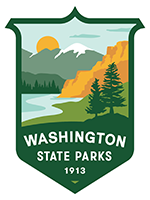Search results
997 results found
Among Lake Sylvia State Park’s peaceful trails and campsites are nearly hidden stories of ventures to wrest timber and hydroelectricity from the landscape.
Indigenous Lands
Lake Sylvia State Park lies within the traditional territories of Coast Salish Indigenous people whose present-day descendants include members of the Confederated Tribes of the Chehalis Reservation.
Rasar State Park lies midway along the Skagit River’s winding path between the rugged North Cascade Mountains and the Salish Sea. The Skagit River, part of the National Wild and Scenic Rivers System, is the second largest river on the west coast of the contiguous United States, after the Columbia. Like much of the Skagit River Valley, the park land is naturally terraced as the river has cut into glacial deposits from the ice age.
OLYMPIA — As a proud member of the Washington Clean Coast Alliance, the Washington State Parks and Recreation Commission (Parks) will co-host the annual International Coastal Cleanup on Saturday, Sept. 21.
This year’s event will take place at six state parks: Cape Disappointment, Fort Worden, Grayland Beach, Ocean City, Pacific Beach and Twin Harbors.
Lewis and Clark State Park preserves precious remnants of once-common southwest Washington landscapes along a historic Indigenous travel route.
Indigenous Lands
The park lies within the traditional territories of Coast Salish Indigenous people whose present-day descendants include members of the Cowlitz Indian Tribe and Confederated Tribes of the Chehalis Reservation. For thousands of years this area has provided habitat for a diverse community of life that forms the basis of their cultures.
Illahee State Park takes its name from the Chinook jargon word for “homeland.” The park lies within the traditional territories of Coast Salish Indigenous people whose present-day descendants include members of the Suquamish Tribe. Indigenous historian Vi Hilbert noted that today’s park occupies a site known as Xitca’sEb, meaning “to feel a tremor.” Geologists have mapped two main faults of the Seattle Fault Zone running north and south of the park area. The fault zone was the site of a major earthquake 1,100 years ago.
Bay View State Park is perched above the waves of Padilla Bay at the western edge of the Skagit Valley. The scenic spot lies within the traditional territories of Coast Salish Indigenous people whose present-day descendants include members of the Samish Indian Nation, Swinomish Indian Tribal Community, Upper Skagit Indian Tribe, Suquamish Tribe and Lummi Nation. For thousands of years the rich estuary and its extensive eelgrass beds have provided habitat for a diverse community of life that forms the basis of their cultures.
Washington State Parks is now operating the upper campus of Fort Worden Historical State Park. In the coming months, we will begin a planning process to inform the long-term plan for the upper campus. The parks campgrounds are open and remain available for reservations.
State Parks will engage with the Tribes separately to get an understanding of how they want to participate in future planning.
Where: Bald Knob Day Use Area, Mt. Spokane State Park
We will meet in the parking area near the campground and work on replacing picnic tables under the shelter and complete light trail maintenance in the
are.
OLYMPIA – Help protect Washington’s beaches and marine life on Sept. 20 by volunteering at a state park during the annual International Coastal Cleanup.
As a member of the Washington Clean Coast Alliance, the Washington State Parks and Recreation Commission is proud to co-host this opportunity to bring people together who cherish Washington’s coastline to help protect and preserve it.
